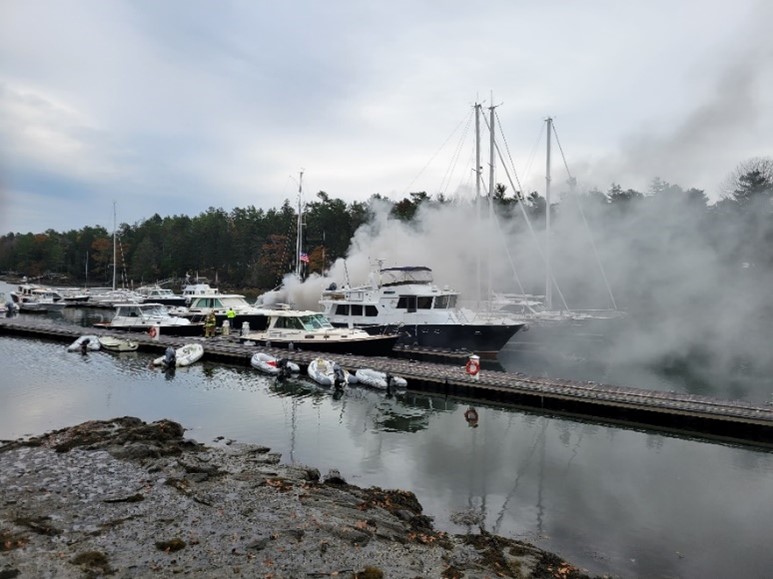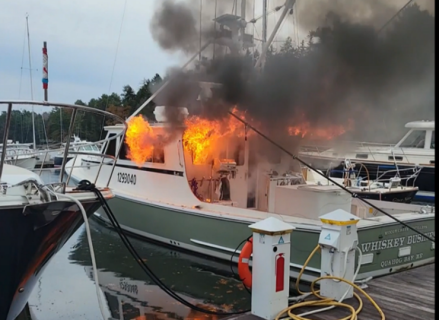Boat Fire at a Marina Dock
Sunday Morning, November 5, 2023
A fire at a marina in Maine destroyed one boat and damaged another. Loss or significant damage to several other boats was averted due to the unusually fast response of the local volunteer fire department. There are several important observations and lessons learned from this incident.
Timeline:
0850: Sunday morning. I arrived at my marina in Harpswell, Maine. I was the only person at the marina. There were no marina staff members (none expected on a Sunday) or other customers present.
0856: I reached my boat (53-foot power boat) moored on the south side of “B” dock. I heard a continuous beeping noise. I did not recognize what this noise was and investigated. I determined it was not coming from my boat. It was coming from “Whiskey Business”, a lobster boat style power boat moored on the north side of “B” dock diagonally across from my boat. Whiskey Business was registered as a commercial fishing vessel, so it was USCG inspected.
I assumed that the beeping (a tone every 2 seconds) was an alarm of some sort. I stepped onto the aft deck of Whiskey Business to see if I could determine the source. I found the very sturdy cabin door locked so I could not enter to determine the source of the alarm. I inspected the cabin through the windows and was able to clearly see all of the main cabin and most of the forward berthing area. I did not see anything unusual.
Since there was no one at the marina, I could not get a key to enter Whiskey Business.

0858: I called my project manager on the marina staff. I explained that I heard an alarm on Whiskey Business, did not see anything amiss, and requested he contact someone on the marina staff to come in to investigate. Project manager agreed and we hung up. I stepped off Whiskey Business and onto the dock. There did not appear to be anyone aboard Whiskey Business.
0901: As I was about to return to my boat, I noticed light white smoke was now visible escaping from a partially open window on the port side of the aft bulkhead of the cabin. I assumed this was from a fire and immediately called 911. I did not attempt to board Whiskey Business because I was talking to 911 and I was by myself in the marina. The 911 agent told me police, fire, and Coast Guard were being notified and gathered information from me. I estimate we spoke for about 5 minutes.
0906 (about): Sheriffs arrived as I finished talking to 911.

0909: US Coast Guard called me on my cell phone for a report on the situation. A member of the marina staff arrived. He was eating breakfast at the restaurant at the marina and saw the police cars arrive. I opened (turned off) the shore power breaker for Whiskey Business.
0911: Smoke was streaming from the partially open window (aft port corner of the main cabin) on Whiskey Business. The marina staff member and I discussed how we could move other boats away from Whiskey Business. Most boats were winterized, and we could not use their engines. We planned to untie them and push them out into the fairway away from the fire.
0913: We saw flames through the windows. Flames were in the aft port corner of the salon. The flames were about 1 foot high.

0915 (about): Two fire trucks and crews arrived. Smoke was heavier and streamed across the dock. Flames were now 2 feet high and coming out of the aft windows of the salon that appear to have all shattered. The first fire fighter attempted to deploy a Fire TKO fire suppression tool (FST) in the salon. FST was provided by the marina. The FST did not activate due to operator error (see appendix).
0918: Interior of cabin appeared fully engulfed in flame. Aftermost window on the port side of the salon shattered and flames rose several feet above the roof of the salon. Other windows started to shatter. Fiberglass outrigger fishing poles melted and fell. Flames reached the radar mast. Varnish started to blister on the boat adjacent Whiskey Business on port side. We made preparations to move adjacent boat. Ultimately the adjacent boat was not moved because the fire department arrived, and we decided the adjacent boat was no longer at risk of major damage.

0923 (about): Fire department started fighting the fire with a 2 ½” fire hose that had been run down the docks to the scene. Flames were streaming out of the salon and across the aft deck of Whiskey Business. Most windows had shattered. Heavy smoke had engulfed the 5 boats around Whiskey Business. Only firefighters in protective gear with air tanks could approach Whiskey Business. All others evacuated from the dock.

0930 (about): Fire was out.

1000 (about): Fire department completed overhauling the fire.
The source of the fire appears to have been a reverse cycle air conditioning unit located under a bench in the aft port corner of the main cabin. (Note this my personal observation and is not an official determination.)
Observations and Lessons Learned
- The audible alarm: It was not obvious that the audible alarm (beeping every 2 seconds) was a smoke alarm. It did not sound like a home smoke detector alarm. My initial response was not as urgent as it would have been if I had known it was a fire alarm. Regulations for commercial fishing vessels require an independent fire alarm in each accommodation space so the odds are that the beeping was a fire alarm.
- Locked cabin door: The door of boat was locked. Because there was no smoke visible and I did not know what the alarm was, I would have entered the boat if the door was unlocked. That might have allowed me to find the problem before the fire was beyond the incipient stage. Note that this is purely my conjecture, and many factors are involved.
- Sound the alarm FIRST! My Navy shipboard training and US Sailing Safety at Sea training both emphasized the importance of sounding the alarm first and not attempting to fight a fire by yourself (I was the only person in the marina when the fire broke out). The ferocity of the fire and the speed at which it spread really drove home the importance of this. ALWAYS sound the alarm first and do not fight a significant fire by yourself.
- Speed of response:
- Minutes mattered in this fire. If I had arrived 30 minutes later than I did, I feel strongly other boats (including mine) would have been engulfed in this fire.
- Good luck: The volunteer fire company drills regularly on responding to fires at this marina. The best-case response time on a weekday is 20 minutes.30 minutes is more realistic, particularly on a Sunday morning. We had an enormous stroke of luck. The fire company was mustered with all their gear and truck conducting training on this Sunday morning. They arrived at the marina only 14 minutes after I called 911. If they had come 15 minutes later, which would have been a typical response time, I think it is very likely other boats would have been lost or severely damaged.
- Always sound the alarm first: The speed at which this fire grew shows why it is so critical to sound the alarm first before taking any other action.
- Speed the fire spread: It was shocking to see how fast the fire spread. It was only 2 minutes from the first wisps of white smoke until the flames and smoke were to the point that I felt we would not have been able to approach the fire, nor would we have been able to put it out with portable fire extinguishers. Within 4 minutes of seeing the first smoke, there would have been no place left that was safe to stand on the boat so if the boat were at sea, the crew would have had to abandon ship.
- Minutes mattered in this fire. If I had arrived 30 minutes later than I did, I feel strongly other boats (including mine) would have been engulfed in this fire.
- Lack of training on the Fire Suppression Tool (FST): The marina’s FST might have been able to reduce the amount of damage to Whiskey Business by extinguishing the fire before the fire hose arrived. However neither those of us assisting nor the fire fighter understood how to properly activate the device. There is one pin that must be removed. This pin is very obvious and is similar to the pin on a fire extinguisher. That pin was removed by the fire fighter. However, after removing the large first pin, a second small pin is exposed and that second pin must be removed to activate the device. Those involved were not aware of the second pin and it was not removed. Thus when the device was thrown into the salon, it did not activate. See the appendix for more detail on this.
Appendix: Fire Suppression Tool (FST)
A FST is a manually activated device about the size of a home waffle iron that deployed sprays “dry spray powdered aerosol” in a room, similar to what a fixed fire extinguishing system might do. These devices are required on commercial fishing vessels. They are not limited to marine use and are also used ashore, for example, carried in police vehicles that may be the first responder to a fire.
The picture shows the device used in this fire.

Pin #1 is large and very obvious. In this situation, that pin was pulled. However, pin #2 and its clip was small and the same color as the handle of the device. (Note that the clip for pin #2 is different in the new FST’s shown in the photo and is more obvious than the clip on the older FST’s we used.) It was not obvious that the clip was attached to a pin or that it needed to be pulled to activate the device. Pin #2 was not pulled and thus the device did not activate.
I have modified my FST by painting the clip for pin #2 yellow so that it is obvious and hopefully will be more obvious that pin #2 must be also removed to activate the device.








